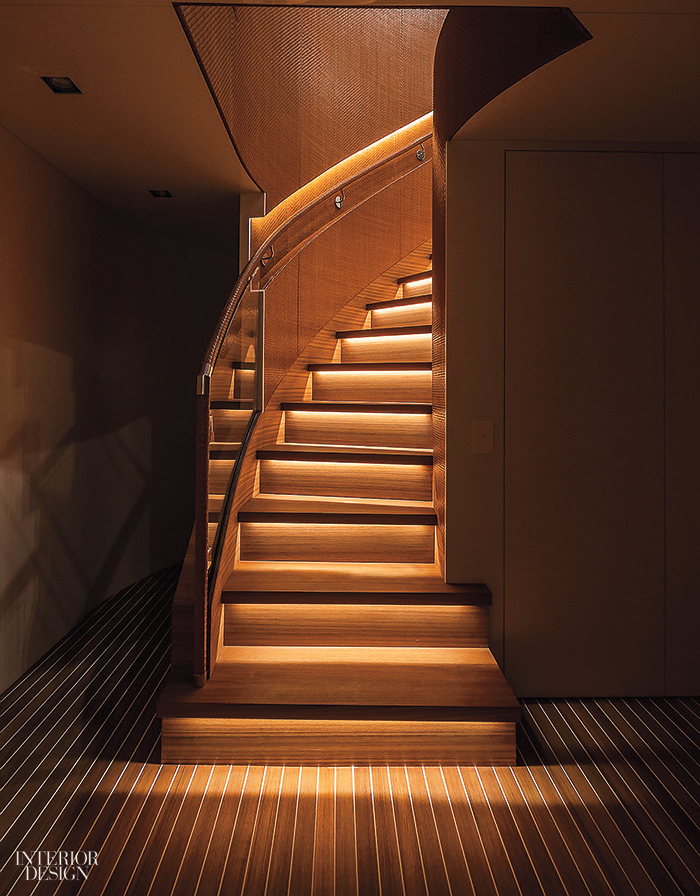Nathan Orsman Illuminates Artwork for Design’s Finest.. and Their Celebrity Clients
Staying in the shadows himself, Nathan Orsman works with Interior Design Hall of Fame members—from modernist-minded Harry Bates and Paul Masi to traditionalist Bunny Williams—when they need to illuminate the blue-chip art of Mark Rothko, Joel Shapiro, Anish Kapoor, and others. How did Orsman attain this level of expertise? Born in Sydney, he studied mathematics before working in IT at the Australian Securities Exchange. He came to New York to work for a lighting designer, then eight years later went out on his own as Orsman Design. His staff of 30, split between the city and Southampton, now collaborates on houses for Stephen Colbert, Ina Garten, Tommy Hilfiger, and Oprah Winfrey. Here’s how Orsman approaches projects.
 Interior Design: Could you describe your philosophy?
Interior Design: Could you describe your philosophy?
Nathan Orsman: I do not like environments that are overly lit.
ID: Are clients sometimes leery
of lighting?
NO: This morning, I was in a meeting with Meyer Davis Studio, and the clients said, “I don’t want to intentionally light the art.” Maybe it wasn’t important enough. Or they didn’t like the idea of coming across as saying, “Here’s my this, that, and the other.” I argued that we can control how important something feels by putting the light there and then using a dimmer to soften and layer it in. Of course, it’s also about the edit. I might decide that, with four proposed fixtures, one will be in your eyes when you come around the corner, and we’ll do just three.

ID: Do you have a go-to architectural fixture for
art indoors?
NO: Yes, 45-degree adjustables with softening lenses to avoid scalloping. For example, a massive collector with a Rothko in the entry hall wasn’t happy because wall-washers lit the painting the same as the background. There was no poignancy or interest, so I swapped out the wall-washers. When you walk by a room, the art should be brighter, while everything else you see is softer.
ID: What about sculpture displayed outdoors?
NO: For viewing during the day, we really hide the fixtures as much as we can. High up in a tree can be ideal, putting distance between the light and the art. Too close, you get spottiness. The other thing that is very important to me is not to light work from every angle. I think that sculpture outdoors should usually be lit from just one side, because the negative space and shadows are especially important.
ID: How do you navigate the dizzying color choices for LEDs?
NO: Lighting for a lovely dinner
is typically 2,300 to 2,400 degrees Kelvin. Halogen at its maximum is 3,200 to 3,300, and I would typically dim that to about 2,700. There is a trend to cooler light for LEDs, with temperatures hovering between 2,800 and 2,900. Someone might like even cooler light, but it’s difficult to live with over time. Those cooler tones trigger awareness of the light rather than of the art.

ID: Are all LEDs good now?
NO: A Color Rendering Index value of 80 was once the best available. Today, CRI is going up, and 98 is the highest. We won’t use anything below 90. Red in an artwork is still a very difficult color to light, so I will do a mock-up, perhaps off-site in a warehouse. Purple can also appear weird when lit, even with a high CRI.
ID: Do you still use halogen?
NO: Yes, though everything that we do outdoors in halogen can be re-lamped with LED. However, that depends on the client. Cheaper LED replacement bulbs will flicker at a perceptible rate, and you can experience a hum or vibration in the light that will offend some people. Watch for it in landscape installations that use those LEDs en masse. You can test by waving your hand in front of the bulb to see if it looks like a strobe.
ID: When would you avoid ceiling fixtures?
NO: We did Cindy Sherman’s photography studio in New York with mono-point spotlights, which offer flexibility between working on art and displaying it. For more traditional environments, I have engineered a line of wall-mounted picture lights, and I am manufacturing them under the name One Illuminates. They cast the light evenly across a whole painting and are furthermore, as far as I know, the only line-voltage LED with no dimming module or power supply needed.

ID: How hands-on are you?
NO: I have 10 full-time technicians who do installations and change lightbulbs or lenses. Because I am extremely particular, I do the adjusting at night myself. I have the ability to control the lighting in the houses of multiple clients, all from my phone.
ID: Once your work is done, how do clients control the light?
NO: Usually with just three buttons on the wall—for high, medium, and low. Sometimes, to get rid of the wall clutter, we use old- school switches and do every- thing behind the scenes. Then, for alternate settings, you have to go into a phone or an iPad. You can spend your whole life walking around a 20,000-square-foot house, trying to set the levels yourself.


